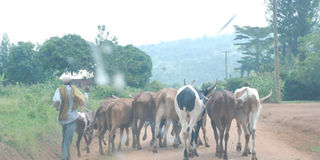Prime
Abundant livestock products an opportunity for side income

Uganda’s cattle population of 11 million and its potential should not be wasted. PHOTO BY EDGAR R.BATTE
In developing economies, livestock is one of the principal sources of food (protein), income and employment. In some African societies, livestock is a symbol of wealth, a source of manure and of recent in countries like Rwanda it is promoted as a source of fuel (biogas).
For over ten years now, local milk production has attained a year-on-year growth ranging between 8 to 10 per cent though this is still below the Dairy Development Authority’s (DDA) 25 per cent annual growth target.
Today, Uganda is producing over 1.5 billion litres of milk per annum. This milk output does not tally with the total cattle population, which is now estimated at 11.4 million (2009 Agricultural Census).
This can be attributed to the fact that; over 90 per cent of the industry is composed of small-scale farmers who have maintained keeping under-productive indigenous breeds.
Though the industry is by far characterised by poor yields resulting from low inputs, many farmers have realised that livestock can be a source of daily income through milk sales, a source of food and custodian of wealth.
Since the industry has shown potential to improve the welfare of the rural farmers, there is an urgent need to come up with strategies to address the major challenges threatening the industry.
Drought
In times of drought, Uganda’s milk production reduces by 50 per cent. This, coupled with poor farming practices and insistence on poor breeds, has left small-scale farmers earning less than the much-sung dollar-a-day.
In addressing the above, there is need to reform the industry. With the changing weather trends, dependence on green pastures can no longer be sustainable. For other continents, except Africa, for decades they have built their livestock farming on hay other than green pastures.
Hay is one form of conserved feed that can be fed to farm animals when other forms of forage are in short supply. Made from green pastures, for Europe, America and some parts of Asia, hay is made in summer and used in winter.
In making good hay, all you have to do is, stop all life processes in the cut grass by reducing its moisture content to below 15 per cent. This is simply done by cutting and sun drying the green pastures.
With a population of 11.4m heads of cattle, we would require 6.156 tons of hay to take us through four months of drought. Selling a ton of hay at Shs20,000, this would turn into a Shs127.68b shilling industry.
What about water?
About seven years ago, my friend MS invested Shs7m to construct a valley dam at his farm.
Today he is annually getting an average of 300 heads of cattle from desperate pastoralists in dire need of water for their herds during dry seasons. This demonstrates the gravity of the matter.
To sort out the water shortage, we have to employ two approaches. The first being digging valley dams where applicable whereas the second involves training and mentoring commercial water harvesters. Rainwater harvesting is the accumulating and storing of rainwater for future use.
Taking a daily average of 50 litres per head of cattle, we require 570m litres of water per day and 68.4bn litres to cover a four months drought. Turning this into an opportunity, we would train 342,000 Ugandans in sustainable water harvesting techniques with each maintaining a 200,000 litre capacity pond. Selling a litre at Shs5, each water harvester would close a season with a million shillings in pocket, thus making it a Shs342bn industry.
With constant milk supplies, we focus on value addition. This will call for enticing people with cash to invest in milk powder production.
Whereas a litre of raw milk in the country side goes for between Shs500 and Shs800, from 100 litres of raw milk we get 13kg of full cream powder milk. The current market price of full cream powder milk is Shs15,000 per kilo. By investing $250,000, you could establish a mini powder milk plant that can process 4,000 litres per hour.
If we could have 20 of such field mini milk powder plants in the country, a sustainable measurably productive job chain would be created, no more milk would go to waste, importation of milk powder especially in the confectionary industry would cease and millions of dollars would be earned from exports
Mr Kayondo is C.E.O/ Lead Consultant at Telesat International
[email protected]




